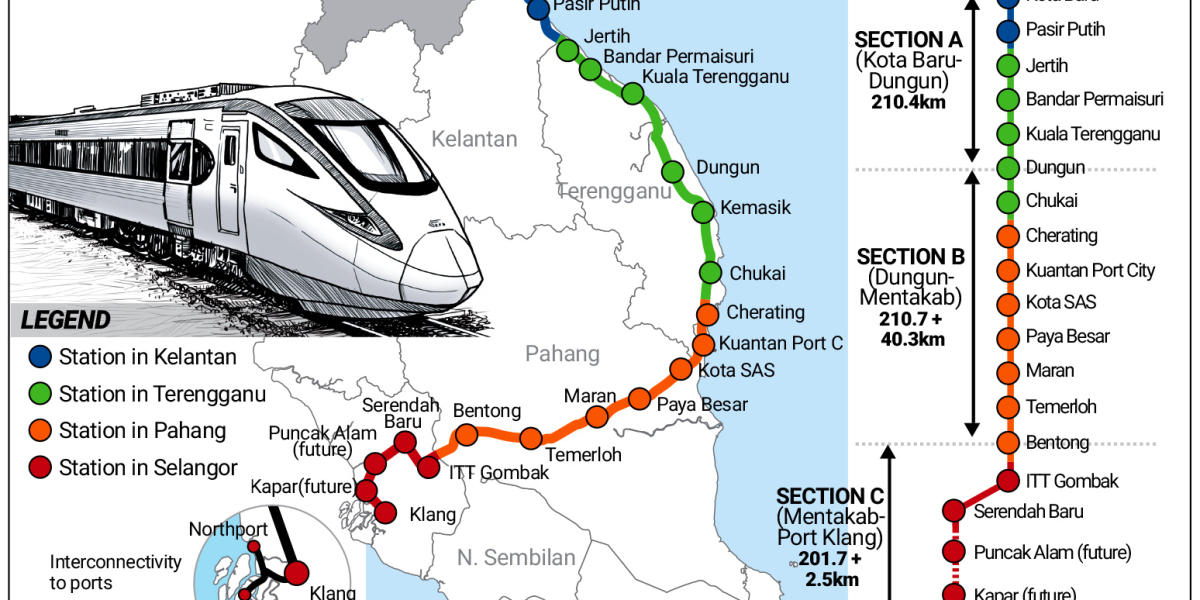The East Coast Rail Link (ECRL) in Malaysia is indeed a fascinating infrastructure project that aims to connect the east and west coasts of the Malaysian Peninsula, promoting economic growth and enhancing connectivity in the region. The ECRL is an extensive railway link spanning approximately 665 kilometers, designed as a standard gauge double-track system.
The project encompasses various components, including spur lines, tunnels, bridges, viaducts, depots, stations, and a signaling system. These elements are crucial in ensuring the smooth and efficient operation of the rail link, providing convenience for both passengers and freight transportation.
When it comes to services, the ECRL has been designed to cater to both inter-city passengers and freight. Passengers will enjoy reduced travel times as they can travel between Kota Bharu and Putrajaya, as well as between Port Klang. With inter-city trains expected to reach speeds of up to 160 km per hour, the estimated journey durations are around four hours and six hours, respectively. Freight trains, on the other hand, will operate at a speed of 80 km per hour, facilitating the efficient transport of goods and boosting economic activity along the rail corridor.
The ECRL will feature a total of 20 stations, with 14 dedicated to passengers, five serving both passengers and freight, and one exclusively for freight services. These stations will act as vital hubs, connecting various cities and towns along the ECRL route, further enhancing transportation and connectivity in the region.
Originally, the ECRL project was planned in two phases. Phase 1 covered a 600.3 km route from Kota Bharu in Kelantan to ITT Gombak in Selangor, while Phase 2 extended from Gombak North to Port Klang, expanding the reach of the railway link. However, due to financial constraints and the need for fiscal discipline, the Malaysian government decided to revise the project and focus solely on Phase 1. This revised plan entails the construction of a 640 km railway line from Kota Bharu to Port Klang, omitting the extension to Port Klang.
The ECRL project is expected to bring numerous benefits to the region. One of the key advantages is the enhancement of transportation and connectivity, providing a faster and more convenient mode of travel between the east and west coasts of the Malaysian Peninsula. This will not only benefit passengers but also facilitate the movement of goods, improving logistics efficiency and trade.
Furthermore, the ECRL has the potential to drive economic growth and development along the rail corridor. The improved connectivity is expected to attract investments, stimulate economic activities, create job opportunities, and contribute to the overall development of the region. Additionally, the project aligns with sustainable development goals by potentially reducing road congestion and carbon emissions, promoting a greener and more sustainable future.
However, it is important to acknowledge that the ECRL project has faced challenges and controversies. The initial cost of the project raised concerns, leading to the revision of the plan to focus on Phase 1 only. The financing of the project has also been subject to debate, with the government exploring different funding options.
Despite these challenges, the ECRL remains an important infrastructure project for Malaysia. As the project progresses, it will be interesting to observe its impact on the Malaysian Peninsula and the opportunities it brings for local communities. The ECRL has the potential to transform transportation, boost economic growth, and contribute to sustainable development in the region.







